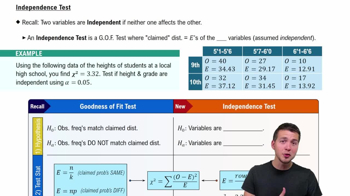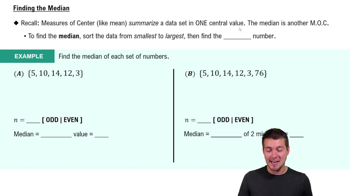Wilcoxon Tests What is the difference between the Wilcoxon signed-ranks test and the Wilcoxon rank-sum test?
Table of contents
- 1. Intro to Stats and Collecting Data1h 14m
- 2. Describing Data with Tables and Graphs1h 55m
- 3. Describing Data Numerically2h 5m
- 4. Probability2h 16m
- 5. Binomial Distribution & Discrete Random Variables3h 6m
- 6. Normal Distribution and Continuous Random Variables2h 11m
- 7. Sampling Distributions & Confidence Intervals: Mean3h 23m
- Sampling Distribution of the Sample Mean and Central Limit Theorem19m
- Distribution of Sample Mean - Excel23m
- Introduction to Confidence Intervals15m
- Confidence Intervals for Population Mean1h 18m
- Determining the Minimum Sample Size Required12m
- Finding Probabilities and T Critical Values - Excel28m
- Confidence Intervals for Population Means - Excel25m
- 8. Sampling Distributions & Confidence Intervals: Proportion1h 12m
- 9. Hypothesis Testing for One Sample3h 29m
- 10. Hypothesis Testing for Two Samples4h 50m
- Two Proportions1h 13m
- Two Proportions Hypothesis Test - Excel28m
- Two Means - Unknown, Unequal Variance1h 3m
- Two Means - Unknown Variances Hypothesis Test - Excel12m
- Two Means - Unknown, Equal Variance15m
- Two Means - Unknown, Equal Variances Hypothesis Test - Excel9m
- Two Means - Known Variance12m
- Two Means - Sigma Known Hypothesis Test - Excel21m
- Two Means - Matched Pairs (Dependent Samples)42m
- Matched Pairs Hypothesis Test - Excel12m
- 11. Correlation1h 6m
- 12. Regression1h 50m
- 13. Chi-Square Tests & Goodness of Fit1h 57m
- 14. ANOVA1h 57m
9. Hypothesis Testing for One Sample
Steps in Hypothesis Testing
Problem 13.CRE.5
Textbook Question
In Exercises 1–10, use the following weights (g) of Hershey’s Kisses from Data Set 38 “Candies” in Appendix B.

Wilcoxon Signed-Ranks Test Repeat Exercise 3 using the Wilcoxon signed-ranks test to test the claim that the sample of weights is from a population with a median of 4.5333 g.
 Verified step by step guidance
Verified step by step guidance1
Step 1: Understand the Wilcoxon Signed-Ranks Test. This test is a non-parametric statistical test used to compare the median of a sample to a hypothesized median. It is particularly useful when the data does not follow a normal distribution.
Step 2: Calculate the differences between each sample weight and the hypothesized median (4.5333 g). For each weight, subtract 4.5333 g to find the difference.
Step 3: Rank the absolute values of the differences from smallest to largest, ignoring the sign of the differences. Assign ranks to these absolute differences.
Step 4: Apply the signs of the original differences (positive or negative) to the ranks. This creates signed ranks for each data point.
Step 5: Compute the test statistic by summing the positive signed ranks and the negative signed ranks separately. Use the smaller of these sums as the test statistic. Compare this test statistic to the critical value from the Wilcoxon Signed-Ranks Test table to determine whether to reject or fail to reject the null hypothesis.
 Verified video answer for a similar problem:
Verified video answer for a similar problem:This video solution was recommended by our tutors as helpful for the problem above
Video duration:
2mPlay a video:
Was this helpful?
Key Concepts
Here are the essential concepts you must grasp in order to answer the question correctly.
Wilcoxon Signed-Ranks Test
The Wilcoxon Signed-Ranks Test is a non-parametric statistical test used to compare two related samples or matched observations. It assesses whether their population mean ranks differ, making it suitable for data that do not meet the assumptions of normality required for parametric tests. This test is particularly useful when dealing with small sample sizes or ordinal data.
Recommended video:
Guided course

Independence Test
Median
The median is a measure of central tendency that represents the middle value in a data set when it is ordered from least to greatest. Unlike the mean, the median is less affected by outliers and skewed data, making it a robust indicator of the data's central location. In the context of the Wilcoxon test, the hypothesis often involves testing whether the median of the sample differs from a specified value.
Recommended video:
Guided course

Calculating the Median
Hypothesis Testing
Hypothesis testing is a statistical method used to make inferences about population parameters based on sample data. It involves formulating a null hypothesis (H0) and an alternative hypothesis (H1), then using sample data to determine whether to reject H0. The outcome is typically assessed using a p-value, which indicates the probability of observing the data if H0 is true, guiding the decision-making process.
Recommended video:
Guided course

Step 1: Write Hypotheses

 6:21m
6:21mWatch next
Master Step 1: Write Hypotheses with a bite sized video explanation from Patrick
Start learningRelated Videos
Related Practice
Textbook Question
